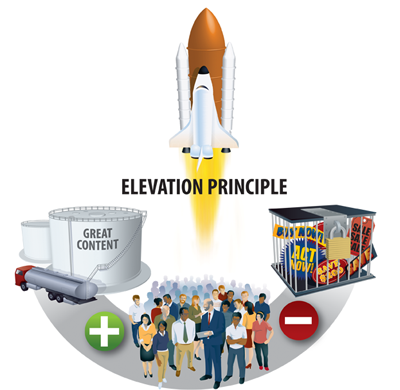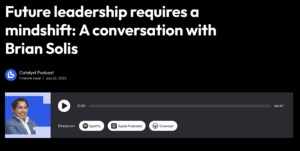
This guest post is by Michael Stelzner, the founder of Social Media Examiner and author of the new book Launch.
Social and selling just don’t mix. Have you ever been to a wedding sponsored by Nike? Does a future where restaurant tables display infomercials sound appealing?
The last thing anyone wants in a social context is a commercial. If you’re responsible for marketing your business, the time for change is now.
It’s time to pack away the marketing messages. If you don’t want to build a loyal and raving fan base, then simply promote the heck out of your products and services via every imaginable social media channel.
However, if you want to build lasting relationships with your prospects and customers, then keep reading.
Why Marketing Must Be Transformed
Here’s how the American Marketing Association defines marketing: “Marketing is the activity, set of institutions, and processes for creating, communicating, delivering, and exchanging offerings that have value for customers, clients, partners, and society at large.”
Focus on two words here: “exchanging offerings.” Most of us have been taught that marketing is about making an offer that attracts people. We’ve been trained to focus on crafting the right arrangement of words and delivering them in the right place, at the right time, using the right medium.
Here’s the problem… We’re treating people like fish. If we just create a better lure than our competitors, silently climb into a boat, and simply cast that bait right on top of our customers, they’ll bite. Or so the theory goes.
And the word “exchange” implies a two-way process between you and the customer. Your business makes an offer and the prospective customer is compelled to comply.
Strong Factors Working Against Marketing
Beyond not treating people like humans, marketers face more two large challenges.
People are tuning out: Channel overload syndrome happens when information is transmitted faster than it can be received. It’s like those intense rainstorms that cause raging rivers, taking out everything in their paths.
Instead of pouring down rain, bucket-loads of information are dumping on the brains of your customers and prospects. And simple umbrellas don’t cut it. As a result, people are retreating, shutting down, and seeking refuge from the information onslaught. People are literally tuning out!
Do people really trust your business?: Fewer than one in three people trust marketing messages, according to Edelman Digital’s annual survey of trust. That’s a pretty dismal number. The study also found that trusting companies is more important than delivering great products and services.
Do your prospects and customers trust you? If great products alone won’t gain the trust of consumers, what will?
If no one is paying attention—and when they do, they don’t trust you—what can your business do to gain the attention and respect of people?
People Are the New Way
If you want to connect with customers and attract raving fans, the solution is very simple: Focus on people. You can meet the needs of people by helping them solve their problems at no cost.
People’s core desires don’t change. Your audience wants access to great insight, great people and recognition. When you help people with their smaller problems, many will look to you for their bigger issues. If you can multiply free assistance by hundreds, thousands or millions of people, you can rapidly grow your business.
Content enables this!
When you provide engaging “how-to” information and assistance in the form of valuable gifts (without strings attached), it triggers the “How much more?” question. “How much more value will I gain if I hire this company or buy this product?” is the response many will have when they see the great value you provide for free.
I’ve developed a simple formula to show you how to grow.
Introducing the Elevation Principle
Here’s my formula for rapid growth. It’s called the elevation principle. When you follow this model, you’ll be able to take your business to new heights.
The elevation principle: Great content PLUS other people MINUS marketing messages EQUALS growth!

Caption: When you combine great content that lacks any obvious marketing messages with other people, your business can rapidly grow.
When you offer great content—such as detailed how-to articles, expert interviews, case studies and videos—that focuses on helping other people solve their problems, you’ll experience growth. Why? Because this type of content meets the needs of people. It doesn’t focus on you, your products or your company. It is a true gift to your audience.
The “other people” component not only means focusing on the needs of people. It also transcends your reader base and involves reaching out to people outside your company, such as industry experts. These outside experts possess amazing knowledge that your audience will find very valuable.
Caption: Tap the minds of other experts and share their knowledge with your audience.
The last part of the formula is to deliver this content in a marketing-free zone. Once the marketing messages are caged, the focus of your company shifts from “What can we sell you?” to “How can we help you?” You shift from pitching products to boosting people.
Instead of investing in ad space, you invest in creating content, experiences, gathering places and communities where people who need help can find it.
You have the chance to own the place people go to for help, eliminating your reliance on traditional marketing channels. You can become the center of your industry, niche or local market. And when that happens, you’re launched on an unstoppable trajectory that will take you places you never imagined possible.
Editor’s note: Be sure to check out Michael’s new book Launch. Click here for free immediate access to the first chapter of the book (no registration required).
Image source: Purchased from iStockPhoto





This is very basic. I’ve been telling my customers this strategy for a decade. Good to see someone more high profile than I talking about it. Thanks for posting, Michael (And Brian).
Hey Mollask – It certainly may seem basic, if only businesses actually practiced it 🙂
Exactly.
Hello,
My name is Anthony Benedict. I have been reading through
your blog and I’m finding it very interesting. I love to write, and I think I
could make a great contribution to your page. If this is something that you
would be interested in, then shoot me a quick email when you get a chance.
Kind regards,
Anthony
Anthony.P.Benedict@gmail.com
Anthony,
Your comment certainly appears pasted in. I’m not sure this kind of promotion is going to get you where you want to go.
To put this in a psychological context, you’re (correctly) suggesting that the right way to deal with the higher walls we’re all building is to give our prospects “gifts” – unexpected, personal and timely “things” – and tap the decision trigger of reciprocity. This is how we create relationships, and it’s tough to sell someone anything, from a Porsche to an idea, if we have no relationship. Too often, marketers skip this step and move right to “exclusivity” – act now or miss out, for a limited time only, etc.
If we spend more time building the relationship and tapping the correct decision triggers (reciprocity, source similarity), we’ll move our prospects along and hopefully end up where we want to go. Amen to that.
I wouldn’t say this is a “marketing-free” zone – I think we’re saying that bad marketing is bad, and bad marketing uses the wrong tools in a clumsy fashion. We just need more chops in how to do it right. It isn’t “marketing’s” fault, but I agree that it’s certainly the fault of the marketer.
Hey Stephen – While I agree with most of what you said, I think we as marketers need to get away with attempting to trigger reciprocity. It’s because so many of us are trying to do this that people don’t trust us anymore.
How does relationship stuff figure in with public relations as a marketing tool?
Very strong co-relation. PR has always been about building strong relationships
I just wrote an article similar to this (I know that’s where you got the idea, Michael)!
Well done on this post. I’m so fascinated by this whole thing, it’s sick. It’s going to take a lot of convincing, a lot of proving the true ROI and a lot of behavioral changes! But hey.. evolution happens either way. I think natural selection is about to happen, real fast.
Awesome post.
Thanks Ryan! I think you’re right that most marketers are kick against this until they begin to see the clear evidence of its power.
I agree with you guys that its all about relationships and content. Most marketers I know are quite open minded about this but the problem I think is not with Marketing or Marketers but the companies and the bosses these marketers work for. There must be a change with the way companies see things, advocated by the marketing people from these companies.
Building relationships is always a smart move. I also find that many potential customers may still be out there waiting for someone or some company to win them over. This is where a smart marketer or business owner comes in. You hold your customers by building great relationships, offer them something more than your competition ever could. This not only dangles the carrot in front of them but keeps them coming back for more. If you want to last in business, you have to find a way to hold those customers who know nothing about loyalty. They simply go where the next best thing is but you can still hold them if you’re wise and know how. Find a way for them to remember you. Bye the way Brian, you’re site looks great, also your YouTube channel. You sure have come a long way baby 🙂
Well said Jeunelle!
I mean – you are really saying people should stop spamming other people’s facebook walls with sales messages – and actually deliver value?!?! ;-)))
Awesome article!!
Thanks and greetings,
André
And where is all this great content going to be seen? That’s right, in mass media paid for by marketing dollars.
I’m a great believer in Andy Sernovitz’s adage that “Advertising is the cost of being boring” but it is essential for things like paying the wages of journalists.
“people are retreating, shutting down, and seeking refuge from the information onslaught.”
And yet the key is to create even MORE content?
better…, instead
Marketing dead? Disagree. I think it depends entirely on the product category, the audience and the channel of the message. I think it was Adam Morgan (correct me if I’m wrong) who said that market leaders communicate in a “conversational manner” i.e. not a relationship-building one. Why? Because these brands don’t need to build relationships. Their categories are so low-involvement that audiences understand the role of their message – get me to buy something that I already buy most of the time. Have a read of some of the Ehrenberg-Bass literature as it might tweak your outlook somewhat. New book by Byron Sharp called How Brands Grow will probably capture all the institute’s thinking over the past few years.
Peace.
Sometimes, it’s hard to face reality, especially when a dream is so alluring. And the alluring dream of green marketing is this: that consumers would cast a vote in favor of a more just and sustainable world whenever they shop.